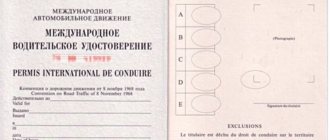- Traffic on tram tracks;
- The intersection of the guide island and the safety island with markings 1.16.1 -1.16.3;
- Stopping and parking;
- Movement along the markings;
Everyone is probably familiar with the story of drying a cat in a microwave oven.
A US woman tried to dry her cat in a microwave oven, as a result of which she naturally died. Then she sued the stove manufacturer because the operating rules did not indicate a ban on drying cats. In order to avoid lawsuits, microwave oven manufacturers began to specify that animals should not be dried in microwave ovens.
The truthfulness of this story is not important, but its absurdity is important. But for some reason, many drivers have the same attitude towards traffic rules as this American woman. If the traffic rules do not indicate a direct prohibition, then it does not exist.
Rule - A decree, an order that establishes the order of something. Inner order rules. Traffic rules.
1.1. These Traffic Rules establish a uniform traffic procedure throughout the entire territory of the Russian Federation.
Rules come first, then movement. The movement follows the rules, and it is not the rules that are substituted for the movement. If it is prohibited, then it is prohibited. If it is allowed, then it is allowed, only as described, and nothing else. Otherwise, this is a violation of the requirements. If the roadway is intended for traffic, then movement outside it is strictly regulated.
Let's move on to examples.
What it is? Definition
We will try not to sprinkle in legal terminology (although we absolutely cannot do without it), but to explain everything in a simple language that is accessible to most.
A traffic island is a place on a median or roadway in the area of a pedestrian crossing where pedestrians can wait to cross the road further.
This may be an area marked only by markings, or both markings and a curb (raised traffic island). In addition, there is GOST R 52766-2007 (regulates elements of the development of public roads), which sets separate standards. We'll talk about them in more detail below.
Let’s immediately make a reservation that we will not consider raised islands, and especially transitions in places equipped with fencing. Few people would think of driving or parking there. Our further task is to deal with the islands, indicated only by markings.
What is a traffic island and is stopping allowed on it?
Hello dear motorists! Each of you held in your hands a book with the rules of movement, you also understand perfectly well what it represents. This is a small booklet consisting of 30 pages, a good half of which are images of traffic lights, traffic controller gestures and road signs. That is, the text of the traffic rules itself consists of about 15 pages of small text, which, like any legislative act, are very difficult to perceive and require explanations, examples and comments. Today we will examine in detail such a term as a safety island.
What does the markup look like for 1.16.1 – 1.16.3? Photo of the safety triangle
It would seem that what could be simpler - take a photograph of the traffic island and provide the reader with its appearance? However, if everything were so simple, the article would end there. But no! The difficulties are just beginning, and it is in the appearance of the markup (or rather in its interpretation) that the main problems, which will be discussed further, lie.
We'll have to turn to GOSTs again. The already mentioned GOST R 52766-2007, in turn, refers to another regulatory act regulating road marking standards. Until recently, this was GOST R 51256–2011 , but has now been replaced by GOST R 51256–2018 .
The safety island designated in these standards is visually different. Let's compare:
| Number | GOST R 51256 – 2011 | GOST R 51256 – 2018 |
| 1.16.1 | ||
| 1.16.2 | ||
| 1.16.3 |
The numbering of these points is the same in both GOSTs. Is the appearance of the islets different? If you look at the photo, it seems that yes, and quite strongly. But in fact, everything is somewhat more complicated. This requires a separate explanation.
What is the difference between markup, and what problems are associated with it?
Under the old GOST, the problem was associated with penalties. There are no specific traffic rules prohibiting driving onto a traffic island. However, motorists received fines. The reasoning was at the intersection of the continuous marking 1.1, which borders the island.
Drivers often insisted that the indicated line was not continuous, but was only part of the overall marking. It was often possible to convince the courts that no violation had occurred.
Now, according to the new GOST, continuous markings in the drawings are completely absent. It may seem that the dispute has been resolved in favor of the participants in the movement, but this is not so - not only has the ban not been lifted, it has become even more obvious !
Let's return to GOST R 52766-2007. Now it states that clause 1.16.1 (according to GOST R 51256 - 2018) is the marking of the area of the traffic island, i.e. marking the interior. It is separately indicated that its boundaries are indicated in accordance with clause 1.1 of GOST R 51256 - 2020 - with a solid inclined line, i.e. it is directly stated that the border of the island is continuous .
Marking illustration 1.1 according to GOST R 51256 – 2018
With difficulty, we sorted out the first problem. Now it is clearly indicated that travel through the traffic island is the intersection of a single continuous road. But that is not all.
Parking in front of the intersection
In other cases, stopping and parking on a traffic island is punished less severely. If the car stops in the neutral zone before crossing roadways, but not within the intersection, then evacuation of the car is not provided, but this act will result in a fine of 500 rubles. This fine is issued not for parking, but for violating the marking requirements. When driving to the island, the driver crossed a solid line, which is punishable by punishment.
By the way, a traffic island is not considered a shoulder, and if sign 3.27 “Stopping is prohibited” is not installed in front of it, then cars can be on it. In cities, the coverage area of sign 3.27 applies only to the part of the street where it is located. The traffic island is usually located in the middle of the roadway and does not fall within the area of the sign.
Why do you need a traffic island?
Before moving on to other issues, let's clarify the parameters of traffic islands. First of all, let’s establish the difference between the internal markings according to paragraphs 1.16.1 – 1.16.3:
- 1.16.1 are straight parallel lines of different lengths. Used to designate islands separating flows of different directions.
- 1.16.2 – broken stripes, whose vertices are directed towards the convergence of flows. Used to designate islands when dividing a flow of one direction.
- 1.16.3 – also broken, but their vertices are opposite to the convergence of the flows. Denotes the merging of a one-way flow.
In most cases, traffic islands comply with paragraph 1.16.1. The rest are more often applicable to guide islands (which are not the topic of this article). However, there are exceptions, so we point out all types of possible markup.
Official definition
Official documents define a traffic island as an element of the road network, clearly marked by a curb or markings. The main purpose is the ability for a pedestrian to wait out the passage of cars in the opposite or similar direction at the point of separation of vehicle flows.
First of all, islands are needed in crowded places, where there is traffic of mothers with strollers, wheelchair users, or heavy vehicle traffic and there is an approaching narrowing of the roadway.
Screenshot of the traffic island
Safety islands help not only pedestrians, but also cars. The screenshot shows that the area is narrowing and the exit zone for cars from the adjacent secondary highway is approaching. When the road curves, there is a high risk of a collision. A traffic island, even one not marked with a zebra crossing, helps traffic in the same direction pass.
Islands are often installed in pedestrian crossing areas. Thanks to them, pedestrians can wait for the lights to turn green on wide boulevards in the middle of the highway. But the main condition is the presence of bollards that block further passage of the car.
Safety island in the pedestrian crossing area
Requirements for a safety island according to GOST
A few more standards. According to GOST R 52766-2007, the following standards exist:
- The flow of vehicles in places where islands are established is at least 400 units/hour.
- The width of the roadway from the edge of the island to the nearest shoulder of the roadway is at least 7.5 m.
- The island cannot be smaller than the width of the pedestrian crossing, and its minimum length is 1.5 m.
GOST R 51256 – 2020 also has its own requirements for marking:
- Line 1.1 “Solid”. This is a white continuous line 0.10 or 0.15 m wide.
- Marking 1.16.1 “Internal marking of the island.” White slanted solid stripes parallel to each other. The width of each strip (a) is 0.40 m. The distance between the strips (c) is 1.2 m. The angle of inclination of the axis of these strips relative to the solid axis (α) is 45˚.
Illustration of marking 1.16.1 in GOST R 51256 – 2018
The lane parameters in paragraphs 1.16.2 and 1.16.3 correspond to the standards of line 1.16.1.
Concept
Road safety islands (ROIs) are a road design element that separates traffic lanes (including bicycle lanes), as well as tram tracks and traffic lanes. Its main purpose is to ensure the safety of pedestrians when crossing the roadway.
OB can be isolated using:
- curbstone (elevation above the roadway);
- technical means of organizing traffic on roads (markings, etc.)
The portion of the median that is crossed by a pedestrian crossing may also be considered a traffic island.
Penalty for driving, stopping and crossing a traffic island in 2020
This is where the main differences and difficulties begin. We have already clarified one problem - crossing a continuous strip (violation of markings - Part 1 of Article 12.16 of the Administrative Code). We will return to sanctions on it later, but for now we will consider other possible violations:
- Is it possible to park on a traffic island? Let us remember that the island is directly connected to the pedestrian crossing. stopping/parking (parking) on a pedestrian crossing (Parts 3 and 6 of Article 12.19 of the Code of Administrative Offenses), can be recognized as a second violation
- At the same time, sanctions may well be applied for parking “further than the right lane ,” which is provided for in Part 3.2 of the same article.
- Article 8.1 of the Russian Traffic Regulations prohibits turning around at a pedestrian crossing . Part 2 Art. 12.14 of the Code of Administrative Offenses of the Russian Federation establishes a fine for this (we’ll return to the exact figures below).
- Article 11.4 of the Russian Federation Traffic Regulations completely prohibits overtaking at a pedestrian crossing . These are relatively recent changes in the rules, and the Code of Administrative Offenses has not yet identified an exact article for the case. However, depending on the circumstances, either the already mentioned violation of markings (Part 1 of Article 12.16 of the Code of Administrative Offenses) or driving into the oncoming lane (Part 4 of Article 12.15 of the Code of Administrative Offenses) is applied.
The amount of fines depends on these conditions. Basically they are like this:
| Violation | Fine | Note |
| Violation of markings (Part 1 of Article 12.16 of the Administrative Code) | 500 rub. | This is how driving onto a traffic island can be interpreted, as well as the minimum penalty for overtaking on the traffic island. |
| Stopping/parking at a crossing (Part 3 of Article 12.19 of the Administrative Code) | 1,000 rub. | Attention: in case of similar violations that occurred in Moscow or St. Petersburg, Part 6 of this article applies - the fine will be 3,000 rubles. |
| Stop/parking “further than the first rad” (Part 3.2 of Article 12.19 of the Code of Administrative Offenses) | 1500 rub. | |
| U-turn at a zebra crossing (Part 2 of Article 12.14 of the Administrative Code) | 500 rub. | A U-turn on a traffic island can be equated to this. |
| Driving into the oncoming lane (Part 4 of Article 12.15 of the Administrative Code). | 5000 rub. or deprivation of rights for up to six months | In this way, the worst-case scenario for overtaking on a traffic island can be interpreted. |
In addition, in some circumstances, a cumulative method of punishment for several articles may be applied.
You need to understand that it is allowed to stop at the markings in the event of a technical malfunction of the vehicle or poor health of the driver.
Stopping in front of a zebra crossing
There are several types of traffic islands. They are created in places where traffic flows in the same direction are separated, in front of pedestrian crossings or in front of intersections. Safety zones in front of pedestrian crossings are placed in order to move traffic lanes as far as possible to the sides and provide a place for people who do not have time to cross the road where they can wait out the red light and wait for the green one.
Parking on the traffic island in front of a zebra crossing is strictly prohibited. A car left there will block the view of both pedestrians and vehicle drivers. As a result, dangerous situations on the road may arise. The rules prohibit stopping cars within 10 meters of the crossing. Motorists who violate this requirement will face punishment under Article 12.19 of the Code of Administrative Offenses of the Russian Federation. For this act a fine of 1000 rubles is imposed. In special cases, the traffic island is marked with yellow markings prohibiting stopping and parking. If it is applied, the vehicle may be towed.
Can a camera record this violation?
Overtaking, turning around, parking on a traffic island - all this can be recorded both by traffic police officers and with the help of cameras. Disputes often arise that the camera is not able to distinguish a stop from a parking lot, but in this case it does not matter - Part 3 (and therefore Part 6) of Article 12.19 of the Code of Administrative Offenses interprets sanctions for both types of this violation in the same way.
The problem may be due to a technical fault. It is not always possible to determine when the hazard warning lights are turned on in a photo. In this case, you will have to appeal the fine for leaving the traffic island.
Is it possible to stop by
As you understand from what was written above, that in the text of the traffic rules, the phrase “safety island” does not appear, then there is no point in looking for an answer to the questions: is it possible to drive in or is it possible to park there?
Here you just need to pay attention to how the boundaries of these elements are marked? That's right, a solid marking line that cannot be crossed. True, there is one exception, but it has nothing to do with our question. By the way, I have written a separate article about solid lines, which describes all their types, purposes and possibilities of their intersection.
It turns out that we cannot cross a solid line, except if it marks the right edge of the roadway for the purpose of stopping on the side of the road, and therefore driving into a traffic island even more so.
Hitting this marking element is punishable in the same way as crossing a solid line, with a fine of 1000–1500 rubles.











